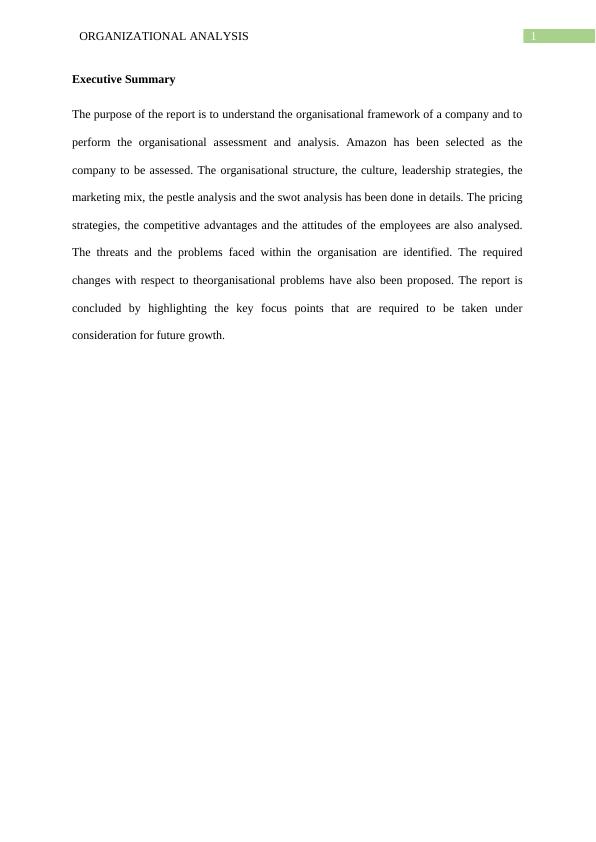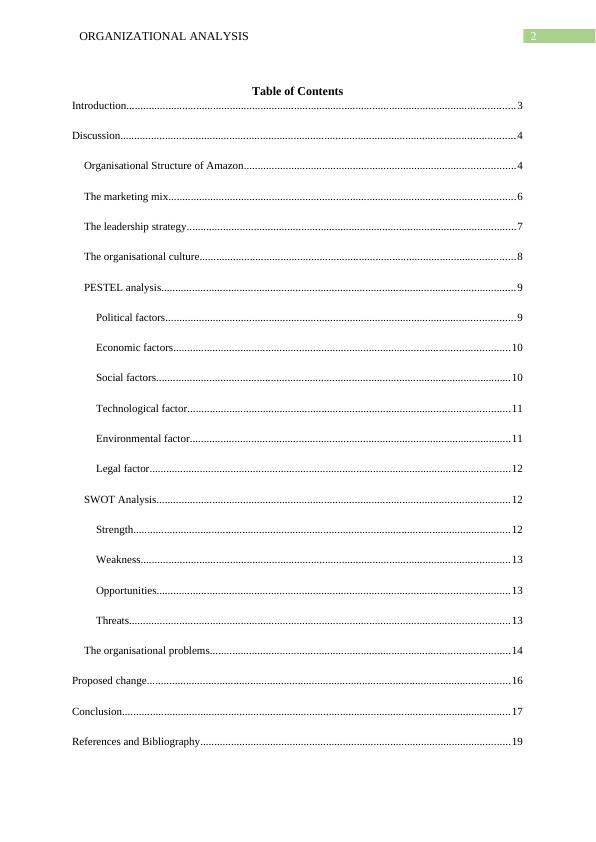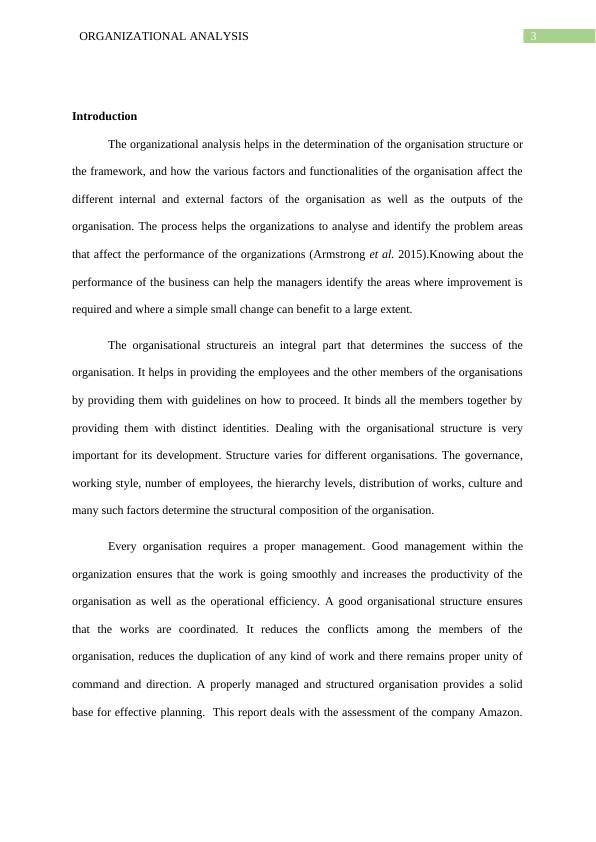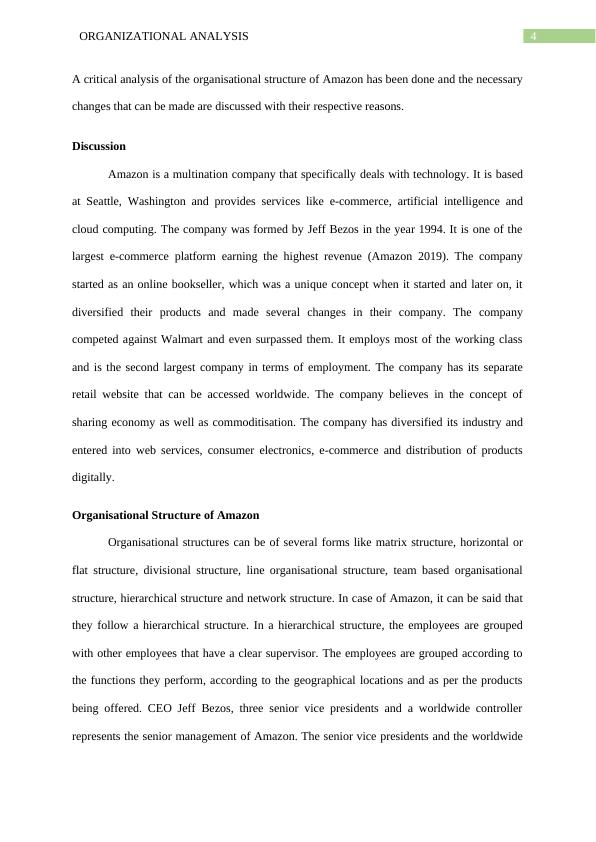Organizational Analysis
Added on 2023-04-08
23 Pages5502 Words382 Views
Running head: ORGANIZATIONAL ANALYSIS
ORGANIZATIONAL ANALYSIS
Name of the Student
Name of the University
Author Note
ORGANIZATIONAL ANALYSIS
Name of the Student
Name of the University
Author Note

1ORGANIZATIONAL ANALYSIS
Executive Summary
The purpose of the report is to understand the organisational framework of a company and to
perform the organisational assessment and analysis. Amazon has been selected as the
company to be assessed. The organisational structure, the culture, leadership strategies, the
marketing mix, the pestle analysis and the swot analysis has been done in details. The pricing
strategies, the competitive advantages and the attitudes of the employees are also analysed.
The threats and the problems faced within the organisation are identified. The required
changes with respect to theorganisational problems have also been proposed. The report is
concluded by highlighting the key focus points that are required to be taken under
consideration for future growth.
Executive Summary
The purpose of the report is to understand the organisational framework of a company and to
perform the organisational assessment and analysis. Amazon has been selected as the
company to be assessed. The organisational structure, the culture, leadership strategies, the
marketing mix, the pestle analysis and the swot analysis has been done in details. The pricing
strategies, the competitive advantages and the attitudes of the employees are also analysed.
The threats and the problems faced within the organisation are identified. The required
changes with respect to theorganisational problems have also been proposed. The report is
concluded by highlighting the key focus points that are required to be taken under
consideration for future growth.

2ORGANIZATIONAL ANALYSIS
Table of Contents
Introduction...........................................................................................................................................3
Discussion.............................................................................................................................................4
Organisational Structure of Amazon.................................................................................................4
The marketing mix............................................................................................................................6
The leadership strategy......................................................................................................................7
The organisational culture.................................................................................................................8
PESTEL analysis...............................................................................................................................9
Political factors.............................................................................................................................9
Economic factors........................................................................................................................10
Social factors...............................................................................................................................10
Technological factor...................................................................................................................11
Environmental factor...................................................................................................................11
Legal factor.................................................................................................................................12
SWOT Analysis..............................................................................................................................12
Strength.......................................................................................................................................12
Weakness....................................................................................................................................13
Opportunities..............................................................................................................................13
Threats........................................................................................................................................13
The organisational problems...........................................................................................................14
Proposed change..................................................................................................................................16
Conclusion...........................................................................................................................................17
References and Bibliography...............................................................................................................19
Table of Contents
Introduction...........................................................................................................................................3
Discussion.............................................................................................................................................4
Organisational Structure of Amazon.................................................................................................4
The marketing mix............................................................................................................................6
The leadership strategy......................................................................................................................7
The organisational culture.................................................................................................................8
PESTEL analysis...............................................................................................................................9
Political factors.............................................................................................................................9
Economic factors........................................................................................................................10
Social factors...............................................................................................................................10
Technological factor...................................................................................................................11
Environmental factor...................................................................................................................11
Legal factor.................................................................................................................................12
SWOT Analysis..............................................................................................................................12
Strength.......................................................................................................................................12
Weakness....................................................................................................................................13
Opportunities..............................................................................................................................13
Threats........................................................................................................................................13
The organisational problems...........................................................................................................14
Proposed change..................................................................................................................................16
Conclusion...........................................................................................................................................17
References and Bibliography...............................................................................................................19

3ORGANIZATIONAL ANALYSIS
Introduction
The organizational analysis helps in the determination of the organisation structure or
the framework, and how the various factors and functionalities of the organisation affect the
different internal and external factors of the organisation as well as the outputs of the
organisation. The process helps the organizations to analyse and identify the problem areas
that affect the performance of the organizations (Armstrong et al. 2015).Knowing about the
performance of the business can help the managers identify the areas where improvement is
required and where a simple small change can benefit to a large extent.
The organisational structureis an integral part that determines the success of the
organisation. It helps in providing the employees and the other members of the organisations
by providing them with guidelines on how to proceed. It binds all the members together by
providing them with distinct identities. Dealing with the organisational structure is very
important for its development. Structure varies for different organisations. The governance,
working style, number of employees, the hierarchy levels, distribution of works, culture and
many such factors determine the structural composition of the organisation.
Every organisation requires a proper management. Good management within the
organization ensures that the work is going smoothly and increases the productivity of the
organisation as well as the operational efficiency. A good organisational structure ensures
that the works are coordinated. It reduces the conflicts among the members of the
organisation, reduces the duplication of any kind of work and there remains proper unity of
command and direction. A properly managed and structured organisation provides a solid
base for effective planning. This report deals with the assessment of the company Amazon.
Introduction
The organizational analysis helps in the determination of the organisation structure or
the framework, and how the various factors and functionalities of the organisation affect the
different internal and external factors of the organisation as well as the outputs of the
organisation. The process helps the organizations to analyse and identify the problem areas
that affect the performance of the organizations (Armstrong et al. 2015).Knowing about the
performance of the business can help the managers identify the areas where improvement is
required and where a simple small change can benefit to a large extent.
The organisational structureis an integral part that determines the success of the
organisation. It helps in providing the employees and the other members of the organisations
by providing them with guidelines on how to proceed. It binds all the members together by
providing them with distinct identities. Dealing with the organisational structure is very
important for its development. Structure varies for different organisations. The governance,
working style, number of employees, the hierarchy levels, distribution of works, culture and
many such factors determine the structural composition of the organisation.
Every organisation requires a proper management. Good management within the
organization ensures that the work is going smoothly and increases the productivity of the
organisation as well as the operational efficiency. A good organisational structure ensures
that the works are coordinated. It reduces the conflicts among the members of the
organisation, reduces the duplication of any kind of work and there remains proper unity of
command and direction. A properly managed and structured organisation provides a solid
base for effective planning. This report deals with the assessment of the company Amazon.

4ORGANIZATIONAL ANALYSIS
A critical analysis of the organisational structure of Amazon has been done and the necessary
changes that can be made are discussed with their respective reasons.
Discussion
Amazon is a multination company that specifically deals with technology. It is based
at Seattle, Washington and provides services like e-commerce, artificial intelligence and
cloud computing. The company was formed by Jeff Bezos in the year 1994. It is one of the
largest e-commerce platform earning the highest revenue (Amazon 2019). The company
started as an online bookseller, which was a unique concept when it started and later on, it
diversified their products and made several changes in their company. The company
competed against Walmart and even surpassed them. It employs most of the working class
and is the second largest company in terms of employment. The company has its separate
retail website that can be accessed worldwide. The company believes in the concept of
sharing economy as well as commoditisation. The company has diversified its industry and
entered into web services, consumer electronics, e-commerce and distribution of products
digitally.
Organisational Structure of Amazon
Organisational structures can be of several forms like matrix structure, horizontal or
flat structure, divisional structure, line organisational structure, team based organisational
structure, hierarchical structure and network structure. In case of Amazon, it can be said that
they follow a hierarchical structure. In a hierarchical structure, the employees are grouped
with other employees that have a clear supervisor. The employees are grouped according to
the functions they perform, according to the geographical locations and as per the products
being offered. CEO Jeff Bezos, three senior vice presidents and a worldwide controller
represents the senior management of Amazon. The senior vice presidents and the worldwide
A critical analysis of the organisational structure of Amazon has been done and the necessary
changes that can be made are discussed with their respective reasons.
Discussion
Amazon is a multination company that specifically deals with technology. It is based
at Seattle, Washington and provides services like e-commerce, artificial intelligence and
cloud computing. The company was formed by Jeff Bezos in the year 1994. It is one of the
largest e-commerce platform earning the highest revenue (Amazon 2019). The company
started as an online bookseller, which was a unique concept when it started and later on, it
diversified their products and made several changes in their company. The company
competed against Walmart and even surpassed them. It employs most of the working class
and is the second largest company in terms of employment. The company has its separate
retail website that can be accessed worldwide. The company believes in the concept of
sharing economy as well as commoditisation. The company has diversified its industry and
entered into web services, consumer electronics, e-commerce and distribution of products
digitally.
Organisational Structure of Amazon
Organisational structures can be of several forms like matrix structure, horizontal or
flat structure, divisional structure, line organisational structure, team based organisational
structure, hierarchical structure and network structure. In case of Amazon, it can be said that
they follow a hierarchical structure. In a hierarchical structure, the employees are grouped
with other employees that have a clear supervisor. The employees are grouped according to
the functions they perform, according to the geographical locations and as per the products
being offered. CEO Jeff Bezos, three senior vice presidents and a worldwide controller
represents the senior management of Amazon. The senior vice presidents and the worldwide

5ORGANIZATIONAL ANALYSIS
controller reports directly to the CEO.The segments are also divided as per the function like
information technology, legal operations, and human resources. The head of these segments
report to the CEO.
This structure of the organisation has developed because of the immense size of the
business. The structure can be more specifically stated as a functional structure. The
corporate structure of Amazon is segregated as groups based on global function, divisions in
geography and a global hierarchy. There are several functions being performed by the
organisation. Each of these major functions have their respective group or team with a senior
being allocated to each of them. The functions of the organisation are as below:
i. CEO roles and responsibilities
ii. Amazon web services
iii. Finance
iv. International consumer business
v. Consumer business
vi. Business development
vii. Accounting
viii. Legal
ix. Human resource
A vertical line of command and authority is followed in this organisation. The
directives of the senior manager are followed by all individuals within the organisation. It
facilitates the managerial control of the entire organisation. The company is however very
much flexible and is adaptable to the frequent market place changes.The organisational
culture of the company is based on cost consciousness, innovation and reinvention, and
continuous improvement.
controller reports directly to the CEO.The segments are also divided as per the function like
information technology, legal operations, and human resources. The head of these segments
report to the CEO.
This structure of the organisation has developed because of the immense size of the
business. The structure can be more specifically stated as a functional structure. The
corporate structure of Amazon is segregated as groups based on global function, divisions in
geography and a global hierarchy. There are several functions being performed by the
organisation. Each of these major functions have their respective group or team with a senior
being allocated to each of them. The functions of the organisation are as below:
i. CEO roles and responsibilities
ii. Amazon web services
iii. Finance
iv. International consumer business
v. Consumer business
vi. Business development
vii. Accounting
viii. Legal
ix. Human resource
A vertical line of command and authority is followed in this organisation. The
directives of the senior manager are followed by all individuals within the organisation. It
facilitates the managerial control of the entire organisation. The company is however very
much flexible and is adaptable to the frequent market place changes.The organisational
culture of the company is based on cost consciousness, innovation and reinvention, and
continuous improvement.

End of preview
Want to access all the pages? Upload your documents or become a member.
Related Documents
Business Development Plan of Amazonlg...
|54
|13973
|180
Organizational Changes United States Report 2022lg...
|24
|5312
|22
Leadership and Business Enviroment -Casa Studylg...
|13
|3997
|28
Leadership and Managementlg...
|22
|4580
|90
Creating Change Through Strategic Communicationlg...
|20
|5629
|25
Amazon Case Study: SWOT and PESTEL Analysis, Leadership Style, Social Responsibilitieslg...
|11
|3285
|78
